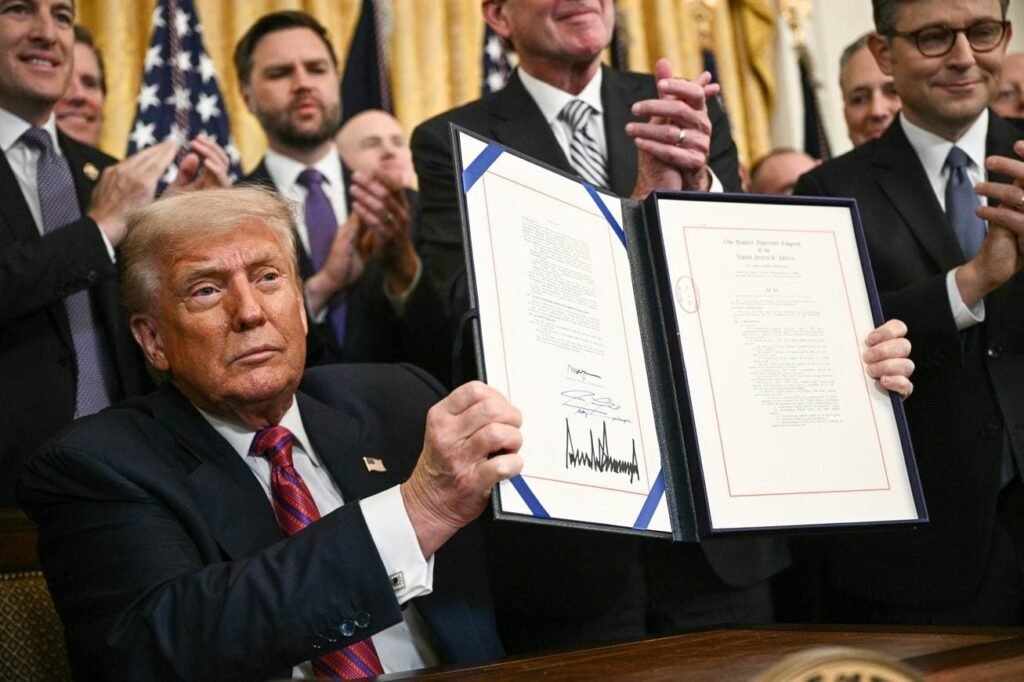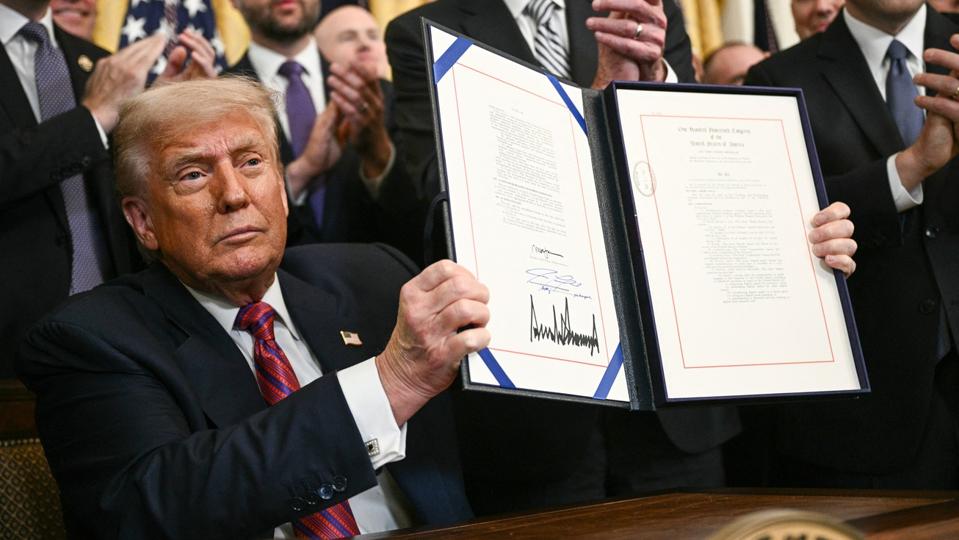TOPSHOT – US President Donald Trump displays the GENIUS Act (Guiding and Establishing National Innovation for US Stablecoins Act), which codifies the use of stablecoins on July 18, 2025. (Photo by Brendan SMIALOWSKI / AFP) (Photo by BRENDAN SMIALOWSKI/AFP via Getty Images)
AFP via Getty Images
With the GENIUS Act signed, stablecoins are on a tear. According to the management consultancy McKinsey, the total value of issued stablecoins has doubled to $250 billion today from $120 billion 18 months ago, and it is forecast to reach more than $400 billion by year-end (and $2 trillion by 2028). Wow. In addition to stablecoins tokens, a number of yield-bearing tokens are out there now. These tokens, typically an investment in short-duration government securities, such as the BlackRock USD Institutional Digital Liquidity Fund ($2.9 billion) and the Franklin OnChain U.S. Government Money Fund ($0.8 billion). Big money, and hence the reasons for the “Layer 1” or “Layer 2” discussions in decentralised finance (DeFi) circles.
Who Cares About Layer 1 or Layer 2?
I am sure you are all familiar with the distinction, but for those who are new to this space, when DeFi people talk about Layer 1 they mean a distributed ledger of some kind (such as the Bitcoin blockchain) whereas Layer 2 networks run on top of the Layer 1 blockchains in order to delivered improved performance or additional functionality. The Layer 2 networks execute transactions off of the ledgers but use Layer 1 to provide the underlying security and finality. So, for example: Bitcoin is a Layer 1 protocol, but on top of this people have built Lightning, which is a Layer 2 service that uses off-chain “payment channels” to make Bitcoin transactions work at point-of-sale (POS). Similarly, Ethereum is a Layer 1 blockhain and Arbitrum is a Layer 2 service that uses a “rollup” mechanism to anchor transactions.
Well, so far, so technical. But there is escalating competition in this space and that has business implications. The news that major players, such as Circle and Stripe, are developing their own Layer 1 networks is rather interesting. Given their investments in the stablecoin space it seems logical for Stripe, for example, to create a new high performance Layer 1 blockchain specially designed to for payment processing. Their blockchain, known as “Tempo”, is compatible with Ethereum’s programming language so developers will be able to easily migrate “smart” “contracts” to the new blockchain.
Similarly, Circle announced its new Layer-1 blockchain “Arc” (also compatible with the Ethereum programming language) which they say is optimised for stablecoin-based financial services. Arc has native support for the Circle Payments Network (CPN) and stablecoins including USDC, EURC and USYC1. It also has, rather interestingly from my point of view, an opt-in privacy schemes that offers selectively shielded transactions. Circle say that Arc is designed not only for stablecoins but for all forms of digital money and tokenized value in the future, a point I will return to later on.
Creative finance.
© Helen Holmes (2024).
Now you might ask, since Bitcoin and Ethereum seem to work, why are serious players in the stablecoin space looking to build their own Layer 1 blockchains while others are already building Layer 2 rails (such as Robinhood’s chain on Arbitrum and Coinbase’s Base on the OP Stack) that also seem to work. There are, broadly speaking there are two business pressures: functionality and economics.
Functionality first. A good reason to develop a Layer 1 is to ensure the development of features that are required by the ecosystem. Now that this infrastructure is no longer a technical detail but a defining factor in who leads the next phase of digital finance, business is paying attention and as stablecoins begin to be used in mainstream business applications, so operational pressures will increase and favour platforms that are secure, compliant and capable of high-throughput transactions.
As the respected industry commentator Noelle Acheson noted in the case of both Circle and Stripe, these will be the priorities of most financial services players but they are not necessarily the priorities of blockchains such as the Bitcoin blockchain, which was optimised for censorship resistance. There is also the element of control: decentralisation sounds good but it would be annoying to find that your payroll payments to employees are held up because everyone is playing some sort of cryptokitties game or messing around with NFTs.
Then there are the economics. The fact is that running decentralised network is expensive. If you want the censorship resistance of Bitcoin then you have to consume enormous amounts of energy and therefore charge significant fees. This is a key reason people started building Layer 2 networks in the first place. But if you don’t need the pseudonymity and censorship resistance (ie, you are running a regulated financial service) then you can redesign the infrastructure in a far more cost-effective way. You can imagine, then, that if Stripe offers stablecoin services to its global customer base, it will offer them its own stablecoins running over its own network and the transactions will never go anywhere near the world’s banking networks except for on- and off-ramps. Assuming, that is, that Stripe’s customers won’t want to hold stablecoin balances that are non-interest bearing.
(Of course once the service is up and running then Stripe can offer their infrastructure to third-parties so that they can use the Stripe Layer 1 to provide stablecoin services to their own customers. Given that payments are such a huge, but vulnerable, profit pool for the TradFi incumbents they they will have to respond.)
Layer 1 And The Real World
Where does this take us then? I suspect that the average consumer (eg, me) will have zero interest in Layer 1 or Layer 2 of indeed how any payments get anywhere. If I tell my accounting package to go ahead and pay a supplier in Canada, I really do not care how the money gets there: if Stripe uses open banking to take the money out of my UK account, take Canadian Dollar stablecoins from their Treasury and then send these stablecoins over to Canada where they are then paid out to the supplier using Interac e-Transfer, or whether they send the money from my bank account via SWIFT to a Canadian bank account, I do not care. Hence the winners and losers here will be determined by their cost-benefit performance for business.
The battle for Layer 1, though, is not only about the battle to control payments, because it is about much more than stablecoins. As Circle indicated, it is about the future of value, a future in which the continuous exchange of “real world” digital assets replaces the traditional infrastructure (and associated overheads) of clearing and settlement vanish. In this world, the next-general financial market infrastructure of distributed ledgers, tokens and protocols (that is, “defi”) that will in essence become critical national infrastructure. Can this really be provided Circle or Stripe? Or will it ultimately need Big Tech or governments or someone else to deliver the platform for innovation?


